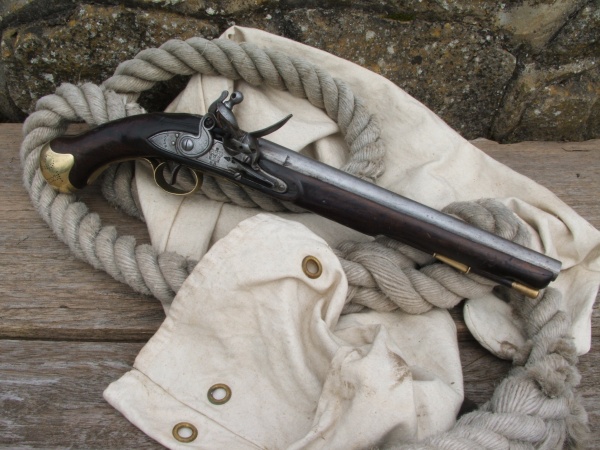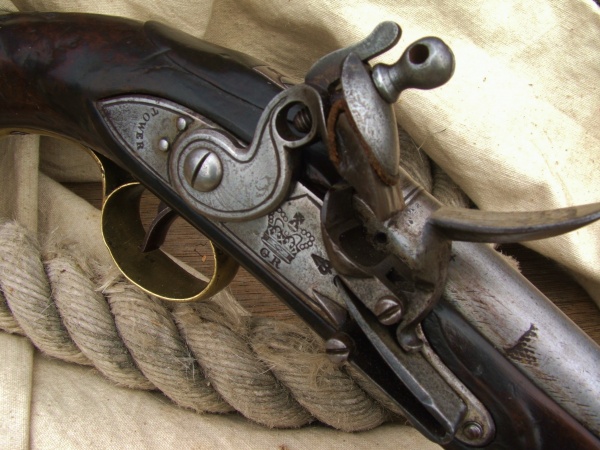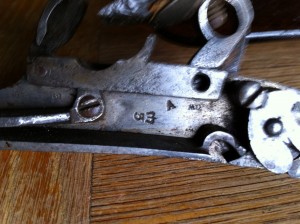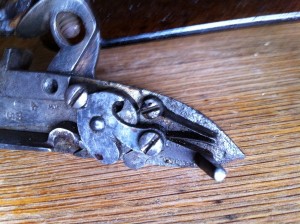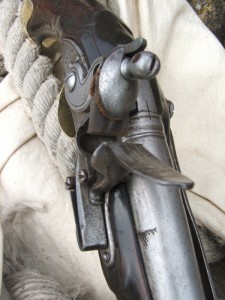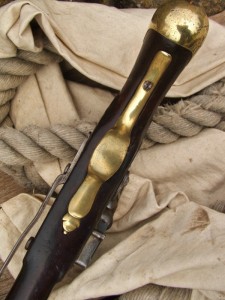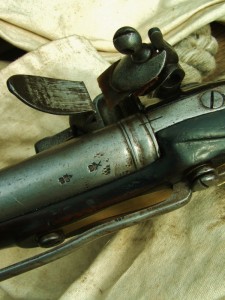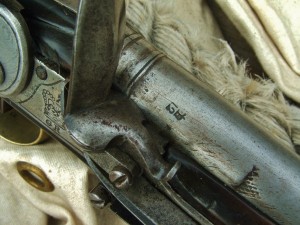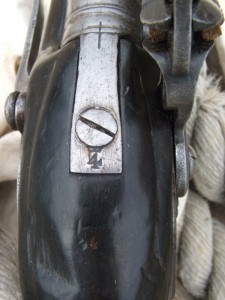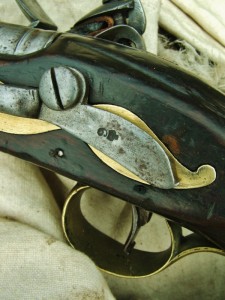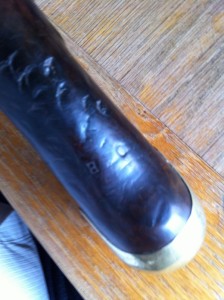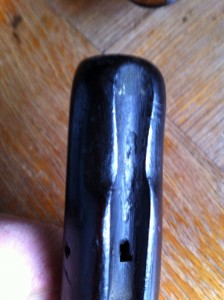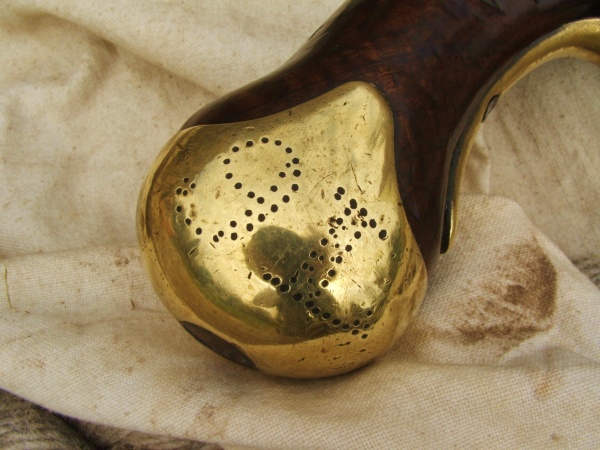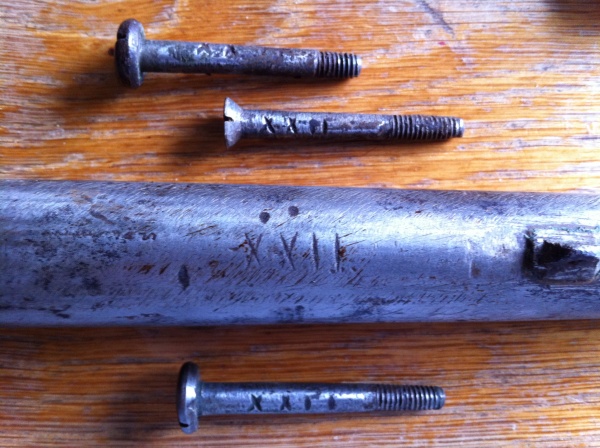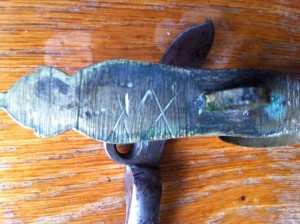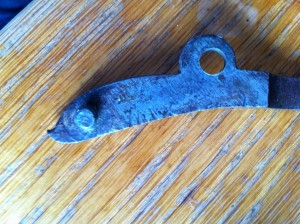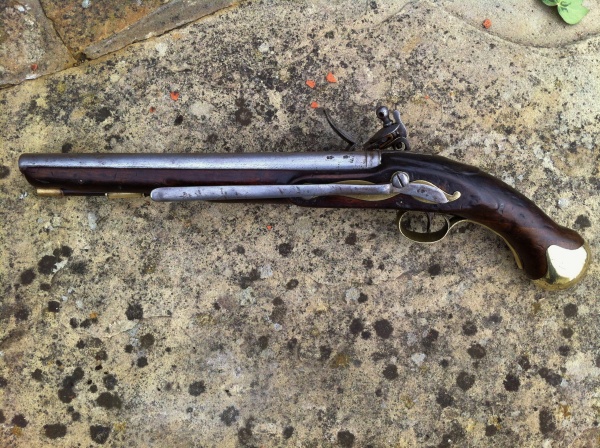Tower Long Sea Service Pistol…………..SOLD
Created on April 15th 2013
A Good Long Sea Service Pistol
The is a standard issue Tower built Long Sea Service that served in the British Navy from approximately 1740 to 1840. This model has the long ears on the brass butt-cap and the full length barrel. It is fully stocked in best English Walnut and has a 12″ .58 caliber round barrel. The weapon is smooth bored.
These pistols were relatively plain in construction as always proposed to be a military weapon. It is a Flintlock with a single shot capacity. Overall it measures 19.1/2″ in length. It has a 12″ wooden brass tipped ramrod which stores under the barrel. Within the ram-rod channel are the hint of inspectors marks towards the front end and a clearer “55” towards the rear of the same.
The lock work on the inside of the lock plate is in excellent order. Unlike a commercial weapon there are signs of the ingress of water, causing rust, but this is only towards the tail. This is actually reassuring, as it hints to the fact that it has been to sea, were rust can get anywhere. There are clear lock makers marks and inspection stamps within the lock.
The cocking piece is what is termed the ‘ring-neck’ type – used for added strength, as this was discovered to be the weakest part of the weapon in usage. The plain frizzen (or striker plate) which closes over the priming pan is also spring loaded. The mechanism is all mounted on the the flat border engraved lock-plate. The tail is marked “TOWER.” Between the cocking piece and the frizzen there is a clear Crown over “G.R” and adjacent to that is the ‘Crown over Arrow’ inspectors mark, denoting inspection at the the Tower of London. Both springs are strong and the flint sparks well on the frizzen (some replica parts fail to spark) As time has passed, it is reasonable to say, that these weapons were worked on by people who were less than careful, with them, than we are today. To this end, there a two patches on the barrel which have the impressions of crude vise jaws on them. Both of the these marks are visible above the stock-work.
The barrel is plain and un-sighted with a “crown over 12” inspectors mark on the lock plate side. On the other side are two clear marks, firstly, from the breech end of the barrel the “crown over crossed scepters” and secondly the “crown over GR, over broad arrow”. On top of the breech is a registration mark that aligns with the tang, this looks undisturbed. At the rear of the same is a clear “4” under a crown. The crown is only partially visible because of the fixing screw hole and head. Around the barrel tang is a carved “apron” in the stock. This has sustained damage in the form of a large chip which is missing from the rear left hand side. This does not detract from the overall appearance of a military weapon that is two hundred odd years old.
There is a sprung belt or sash hook on the other side which has been bent in use. The belt hook is also inspector stamped with a clear “6” under a crown. The walnut stock is dark in appearance but grain is still visible through the patina. There are the usual dents and dings associated with use and storage and then there are the hammer marks on the rear of the stock ! The weighty butt and butt cap of this weapon were designed to be used in close quarters fighting as a handy cudgel which would easily crack a mans skull open. One only has to turn the weapon around in the hand to feel the balance of this Sea Service pistol, and appreciate its effectiveness as such a tool. Unfortunately, there are other tools in the world who have used these things for incorrect purposes – hammering things. There are thirteen identical half-moon dents in the rear of the stock which have been inflicted upon the weapon, by a weapon……what can you say !….. All these items have been through a period of relatively low value, one can only assume this damage occurred within such a period of time. In a strange kind of way I can live with them, its also just possible that they occurred within its period of service.
This sea Service has the correct brass furniture associated with the period, but most interesting is the butt cap itself. It has been numbered using a punch. In double lines of dots it is marked ” 9 L ” One can only guess at the meaning but I would take a stab in the dark and assume it is a rack and deck number. Number Nine, lower deck ?
As the patina which covers the wooden stock is so thick it is not easy to see the markings on the stock, but in the right light conditions you catch the marks. On the inside of the grip on the lock side, is an “Arrow over B.O” At the rear, just above the butt cap, is another upside down “O B”. Beside the trigger guard there are two indentations which strongly resemble the expected proof marks in that area of the pistol. There are two pins holding the barrel in place in the fore-end as expected.
On inspection and cleaning many crude marks were found on the inside of the pistol. All of them numbered with similar Roman numerals, namely “XX II” This is assumed to be a basic numbering system to keep parts together. The markings are crude and irregular in shape, probably made by a blunt chisel. The forged screws were marked, the underside of the barrel, the stock, the trigger guard and the back plate. The brass parts were short of a couple of digits, but the same, namely “XX”
Altogether this is a very honest Sea Service Pistol which appears to have seen is fair share of excitement and has the scars to prove it. When and where is anybody’s guess? The only clue I have is that it was sourced from America, maybe it was left it was left behind by the “Brits“
£ SOLD
Comments Off on Tower Long Sea Service Pistol…………..SOLD
